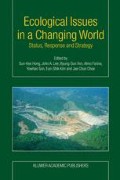The forest area in Korea occupies 6.3 million ha, about 65% of the total land area as of 2000. The forest can be classified into three groups: coniferous (2.7 million ha), deciduous (1.7 million ha), and mixed (1.9 million ha) forests, and most of the dominant species of deciduous and mixed forests are oak (Quercus) species (Korea Forest Service 2001). Oak species occupy a wide variety of ecological conditions and zones ranging from lowland warm temperate to upper montane conditions, and have been intensively utilized for many different purposes in the country. There is no doubt that oak species play the most important role in ecological aspects and production of wood and by-products of the Korean forests. Six deciduous oak species (Q. aliena, Q. acutissima, Q. dentata, Q. mongolica, Q. serrata, and Q. variabilis), few varieties and hybrids are commonly found throughout the country and five evergreen oak species (Q. acuta, Q. gilva, Q. glauca, Q. myrsinaefolia, and Q. salicina) are scattered along the southern coasts and islands. Many of the previous studies investigated biomass and production, and relatively few studies examined nutrient distribution and cycling of the oak forests. However, most of these studies focused on the deciduous oak forests. The primary object of the current study is to provide an overview of biological productivity and nutrient cycling for natural oak forests in Korea. We collect and compare data sets on biomass and nutrient cycling for the species from the literature, and also include our own data from the on-going research project (“Effects of the changes in local environments on the nutrient cycling of the natural oak stands in Korea” supported by the Korea Science and Engineering Foundation- R01-2000-000-00206-0). As nitrogen (N) and phosphorus (P) are the most common nutrient limiting production in temperate forests, our review focuses on N and P as well as organic matter.
Access this chapter
Tax calculation will be finalised at checkout
Purchases are for personal use only
Preview
Unable to display preview. Download preview PDF.
Author information
Authors and Affiliations
Editor information
Editors and Affiliations
Rights and permissions
Copyright information
© 2004 Kluwer Academic Publishers
About this paper
Cite this paper
Son, Y. et al. (2004). Biomass And Nutrient Cycling Of Natural Oak Forests In Korea. In: Hong, SK., et al. Ecological Issues in a Changing World. Springer, Dordrecht. https://doi.org/10.1007/978-1-4020-2689-8_14
Download citation
DOI: https://doi.org/10.1007/978-1-4020-2689-8_14
Publisher Name: Springer, Dordrecht
Print ISBN: 978-1-4020-2688-1
Online ISBN: 978-1-4020-2689-8
eBook Packages: Springer Book Archive

